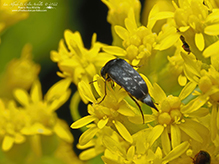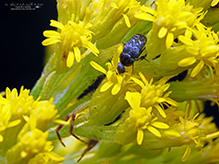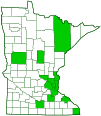tumbling ragdoll flower beetle
(Mordella marginata)
Conservation • Description • Habitat • Ecology • Distribution • Taxonomy
|
|
||||||||||||||
Description |
Tumbling ragdoll flower beetle is a small beetle but a medium-sized tumbling flower beetle. It occurs in the United States and southern Canada east of the Great Plains. The larvae live in dead wood and feed on fungi-infested rotten wood. Known host plants include bur oak, western soapberry, and hickory. Adults are active in June and July. They are found on many species of flowers, often in great numbers. They apparently feed on pollen and nectar. There is little or no relationship between the diets of Mordellidae larvae and adults. Adults are ⅛″ to ¼″ (4.0 to 5.5 mm) in length. The body is wedge-shaped when viewed from above, and it is arched, appearing humpbacked when viewed from the side. It is dull black with grayish or silvery (pale) markings formed by irregular patches of hairs. The markings are highly variable, even among individuals in the same area. It is the most variable of the 25 Mordella species that occur in North America. The head is large, short, bent downward, and black. It is more or less densely covered with pale, ashy-gray hairs. It is attached toward the bottom to the body. There are two large compound eyes and no simple eyes (ocelli). The eyes are large, reaching the back of the head (occiput). They are finely roughened (granulated), and they are covered with minute hairs. The antennae are short, reaching just to the middle of the thorax. They are mostly black, but they are a little lighter at the base. They have 11 segments. Segments 1 through 4 are narrow. Segments 5 through 10 are saw-toothed (serrate), triangular in shape. The mouthparts are directed downward. The finger-like sensory mouthparts (palps) are pale. The last segment is long and more or less triangular. The plate on the upper side of the thorax (pronotum) is small and one-third wider than long. The base is broader than the wing covers (elytra), and it has a broad rounded lobe in the middle. The surface is black with pale markings. There is a band of pale hairs at the front margin, at the base, and on each lateral margin. There is a narrow stripe on each side of the middle, a short line near the hind angles, and an oblique line on each side that reaches the lateral margin. All of these markings are variable and may be mostly obscured. The plate between the wing bases (scutellum) is triangular, rounded at the tip, and covered with pale hairs, at least on the margins. The abdomen is narrow and pointed, and it extends well beyond the end of the elytra. At the tip of the abdomen there is a long, pointed extension (anal style). The anal style is black, and it is covered with pale hairs at the base. The underside of the abdomen is black, and it is covered with pale hairs that are denser at the sides and at the front margin of each abdominal segment. The elytra are black with pale markings. The markings are so variable that no two specimens are alike. On Mordella marginata marginata, the most common subspecies, the markings are irregular spots or blotches. On Mordella marginata lineata, the markings form four to six long lines. The latter subspecies is not as common, but it has about the same range. The length of the beetle from the head to the tip of the elytra, not including the anal style, is ⅛″ (3.0 to 3.5 mm). The legs are slender. The hind legs are long. On the front and middle legs, the last part of the leg (tarsus), corresponding to the foot, has 5 segments. On the front legs, the second and fourth tarsal segments are dilated. On the middle legs, the fourth leg segment (tibia) is as long as all of the tarsal segments of that leg combined. On the hind legs, the tibia has a short ridge near the tip, and the tarsi have just 4 segments. |
Size |
Total length: ⅛″ to ¼″ (4.0 to 5.5 mm) |
Similar Species |
Habitat |
|
Ecology |
Season |
June and July |
Behavior |
When threatened, the beetle may rapidly take flight, or it may kick its legs back and forth, causing it to tumble unpredictably. This is the feature that gives the family Mordellidae the common name tumbling flower beetles. |
Life Cycle |
|
Larva Food |
Fungi infested rotten wood of bur oak, western soapberry, and hickory. |
Adult Food |
Pollen and nectar of many species of flowers |
Distribution |
||
|
Sources |
|
| 4/17/2024 | ||
Occurrence |
||
Common and often abundant |
||
Taxonomy |
|
Order |
Coleoptera (Beetles) |
Suborder |
Polyphaga (Water, Rove, Scarab, Long-horned, Leaf, and Snout Beetles) |
Infraorder |
Cucujiformia |
Superfamily |
Tenebrionoidea (darkling beetles and allies) |
Family |
Mordellidae (tumbling flower beetles) |
Subfamily |
Mordellinae |
Tribe |
Mordellini |
Genus |
Mordella |
Subordinate Taxa |
|
tumbling ragdoll flower beetle (Mordella marginata lineata) tumbling ragdoll flower beetle (Mordella marginata marginata) |
|
Synonyms |
|
|
|
Common Names |
|
tumbling ragdoll tumbling ragdoll flower beetle |
|
Glossary
Elytra
The hardened or leathery forewings of beetles used to protect the fragile hindwings, which are used for flying. Singular: elytron.
Occiput
The back of the head. In Odonata, Megaloptera, and Neuroptera, the upper part of the head behind the eyes.
Ocellus
Simple eye; an eye with a single lens. Plural: ocelli.
Palp
Short for pedipalp. A segmented, finger-like process of an arthropod; one is attached to each maxilla and two are attached to the labium. They function as sense organs in spiders and insects, and as weapons in scorpions. Plural: palpi or palps.
Pronotum
The exoskeletal plate on the upper side of the first segment of the thorax of an insect.
Scutellum
The exoskeletal plate covering the rearward (posterior) part of the middle segment of the thorax in some insects. In Coleoptera, Hemiptera, and Homoptera, the dorsal, often triangular plate behind the pronotum and between the bases of the front wings. In Diptera, the exoskeletal plate between the abdomen and the thorax.
Visitor Photos |
||
Share your photo of this insect. |
||
This button not working for you? |
||
Alfredo Colon |
||
 |
||
MinnesotaSeasons.com Photos |
||
|
||
|
||

Slideshows |
|

Visitor Videos |
||
Share your video of this insect. |
||
This button not working for you? |
||
|
Other Videos |
||
|

Created: 4/17/2024 Last Updated: © MinnesotaSeasons.com. All rights reserved. |



